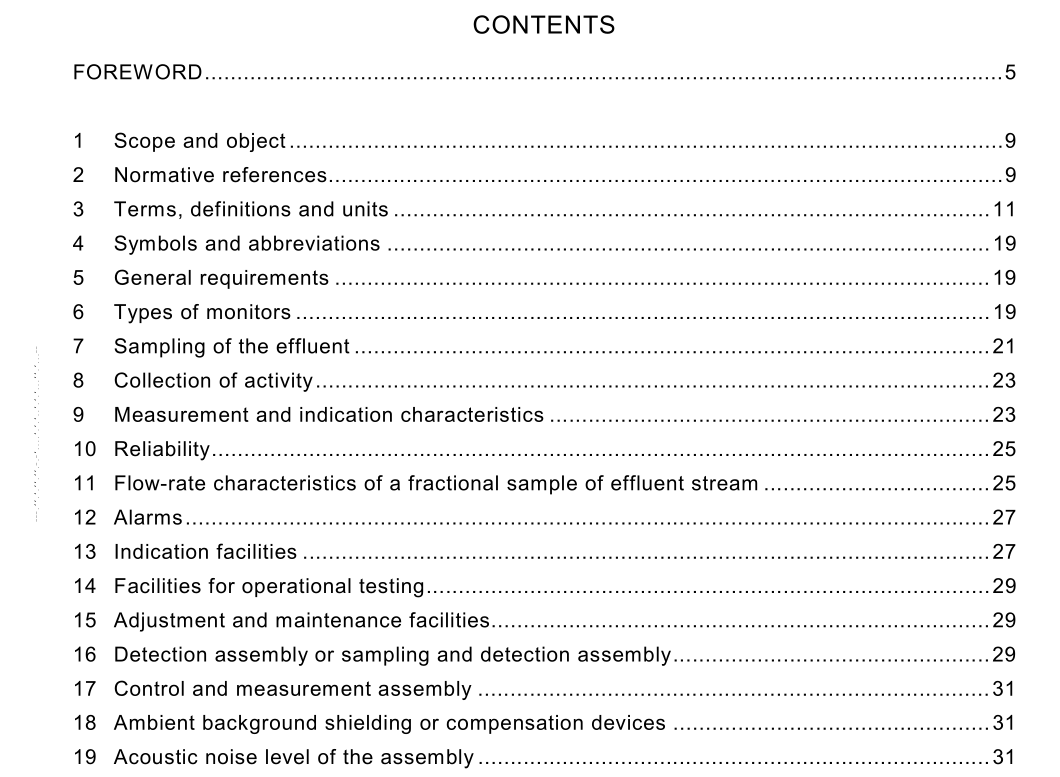IEC 60761-1 pdf download

IEC 60761-1 pdf download.Equipment for continuous monitoring of radioactivity in gaseous effluents
1 Scope and object
This part of IEC 60761 defines acceptable forms of such monitoring, provides some general guidance as to the possible range of measurement and capability of such equipment as may be envisaged, and indicates when and where its uses may be practicable. This standard is applicable to equipment for continuous monitoring of radioactivity in gaseous effluents during normal operations and during anticipated operational occurrences. This standard does not apply to equipment specifically for use in accident conditions. Such equipment may require additional capabilities. This standard is restricted to equipment for continuously monitoring radioactivity in gaseous effluent. It does not deal with sample extraction and laboratory analysis. The object of this standard is to lay down mandatory general requirements and give examples of acceptable methods for equipment for continuous monitoring of radioactivity in gaseous effluents. It specifies, for the equipment described above, the general characteristics, general test procedures, radiation, electrical, safety and environmental characteristics and the identification and certification of the equipment. If this equipment is part of a centralized system for continuous radiation monitoring in a nuclear facility, there may be additional requirements from other standards related to those systems.
3 Terms, definitions and units
For the purpose of this part of IEC 60761, the definitions concerning the detection and measurement of ionizing radiation and nuclear instrumentation given in IEC 60050(393), IEC 60050(394), IEC 60181 and IEC 60181A, and the following, apply. 3.1 gaseous effluent monitor equipment intended for continuous monitoring of radioactivity in gaseous effluents. The different parts of the monitor may conveniently be grouped into two assemblies which may be associated or separated according to the monitoring and operating requirements 3.2 detection assembly includes one or more radiation detectors and associated function units 3.3 control and measurement assembly includes assemblies and function units designed to measure quantities connected with ionizing radiation (activity, volumic activity, etc.). The assembly is provided with function units to give a perceptible warning that the quantity being measured exceeds some predetermined value 3.6 measurement uncertainty parameter associated with the result of a measurement that characterizes the dispersion of the values that could reasonably be attributed to the measurand 3.7 coverage factor numerical factor (k) used as a multiplier of the combined standard uncertainty in order to obtain an expanded uncertainty (see ISO 1995: Guide to the expression of uncertainty in measure- ment) 3.8 decision quantity random variable for the decision whether the physical effect to be measured is present or not 3.9 decision threshold fixed value of the decision quantity by which when exceeded by the result of an actual measurement of a measurand quantifying a physical effect, one decides that the physical effect is present NOTE The statistical test shall be designed so that the probability of wrongly rejecting the hypothesis (error of the first kind) is equal to a given value α. For this standard, α equals 5 %. 3.10 detection limit smallest true value of the measurand which is detectable by the measuring method NOTE The detection limit is the smallest true value of the measurand which is associated with the statistical test and hypotheses (see decision quantity) by the following characteristics: if in reality the true value is equal to or exceeds the detection limit, the probability of wrongly not rejecting the hypothesis (error of the second kind) shall be at most equal to a given value β. For this standard, β equals 5 %. 3.11 effective range of measurement range of the values of the activity to be measured over which the performance of a piece of equipment or an assembly meets the requirements of its specifications 3.12 dynamic range quotient of the signal from the maximum measurable indication of a quantity to the signal from the decision threshold









